#all aboard the starliner express
Text


More fan stands?????? Yes. I’m having a lot of fun!
These are characters for my fanpart, Starliner Express. It takes place on a one-way singles cruise from Miami to Rome. There are no stops. People start developing stands, getting into fights, and breaking things, but for some reason the captain refuses to turn the boat around!
——————————————
「Anger Management」
Stand Abilities: A stand that feeds on other peoples’ hatred for its user. The more hate it consumes, the faster and sharper its claws will become. It uses its USB tail to scrub through the internet for mean comments, but it can also plug into a person and feed off of them if they dislike Issey enough.
「Anger Management」 can also use its tail to diagnose a target’s weak points. If it plugs into a person, object, weapon, etc, its vulnerabilities will be announced by the mouth on its head. It will also make fun of its target, and is known to be quite rude.
Issey can use this ability on himself and his allies to help them identify their own weak points and areas they could improve in. He also uses 「Anger Management」 when he’s practicing singing and dancing to help him perfect his performances. It only critiques though - it can’t offer suggestions or encouragement.
User: Issey Dellavedova
Backstory: An up and coming pop star. Issey loves every aspect of his job - except the fame. As an asexual aromantic he finds the attention from his fans to be incredibly overwhelming, and has been the victim of several stalkers over the course of his short career. When he released his debut album over a year ago, he was a much friendlier person; he would spend hours after a show to talk with his fans, and was well known for being one of the kindest celebrities on the scene. Unfortunately due to the incidents mentioned above, he was forced to become colder and meaner in order to protect himself. His reputation has plummeted as a result, and people now describe him as rude, stuck-up, and dismissive.
He is on the Starliner Express because his agent forced him into a marketing deal with the Cruise Line. He’s being paid an absurd amount of money but is incredibly annoyed by the whole experience. It reminds him of his past trauma. He’s incredibly on edge. His sexuality hasn’t been made public, so despite his poor public image, his PR team has rebranded him as the industry’s bad boy bachelor. Much like Diesel, 「Anger Management」 developed after he took a glitter bomb shot handed to him by a crew member.
Issey has a true love of music. He puts everything into his creative process, and while he hates the attention he gets, he would rather die than stop performing. Despite everything, his music is still well loved.
User Namesake: Issey Miyake is a Japanese luxury fashion house. Matthew Dellavedova was a player for the Cleveland Cavaliers.
Stand Namesake: Anger Management is an album by Rico Nasty: “Treat you like gum spit you out if I ain’t feeling you. I just wanna know why all these bitches so predictable. I can never be typical. Don’t come out the house unless I’m wearin’ something whimsical // From where I made it out, they lookin’ at me like a miracle. Don’t say shit you don’t mean, cause I’m literal.”
——————————
「Rapp Snitch Knishes」
Stand Abilities: It tells the target a secret - something the target really wants to know. If the target tells anyone about the secret, or even hints at it, Rapp Snitch Knishes will beat them senseless as soon as they enter an enclosed room. This room will become soundproof and inescapable from the inside. The target will not be able to leave or call for help during this period.
The stand will deactivate if anyone enters the room, Dior chooses to cancel the attack, or if the target dies. The secret it tells the target doesn’t have to be true.
User: Dr. Dior Gibson
Backstory: The ship’s head doctor. Dior’s allegiances are shrouded in mystery. Her targets include both crew and passengers, and anyone who causes too much trouble on the ship. Her emergency room is full of guests who need immediate medical attention - her small staff can’t get more than two hours of sleep at a time because people keep shuffling in. She will do anything to get the fighting to stop.
Dior is an efficient and professional woman. She only speaks to convey critical information, and uses her words extremely carefully. She is a recent veteran, and used to serve as a surgeon in the Navy’s Medical Corps. Her new job was supposed to be easy money and fun in the sun. Now there’s a bunch of super powered co-eds running around beating the shit out of each other.
Like Diesel and Issey, Dior’s stand 「Rapp Snitch Knishes」 developed after she drank a glass of glittery champagne handed to her by a crew member.
User Namesake: y’all know what Dior is. Gibson is an American Guitar Manufacturer.
Stand Namesake: Rap Snitch Knishes is a song by MF DOOM featuring Mr. Fantastic: “True, there's rules to this shit, fools dare care. Everybody wanna rule the world with tears for fear. Yeah, yeah, tell 'em tell it on the mountain hill. Running up they mouth bill, everybody doubting still // Informer, keep it up and get tested.”
#jjba oc#jojo oc#fanstand#stand oc#Lexi’s bizarre adventure#all aboard the starliner express#jojo’s bizarre adventure#mf doom#Rico nasty#anger management#Rapp snitch knishes#this blog is my quarantine zone so I’m just gonna start posting ocs now.#maybe some hair tutorials too
16 notes
·
View notes
Text
Celebrating Women’s History Month: Most Recent Female Astronauts
For Women’s History Month, NASA and the International Space Station celebrate the women who conduct science aboard the orbiting lab. As of March 2019, 63 women have flown in space, including cosmonauts, astronauts, payload specialists, and space station participants. The first woman in space was Russian cosmonaut Valentina Tereshkova who flew on Vostok 6 on June 16, 1963. The first American woman in space, Sally Ride, flew aboard the Space Shuttle STS-7 in June of 1983.
If conducted as planned, the upcoming March 29 spacewalk with Anne McClain and Christina Koch would be the first all-female spacewalk. Women have participated in science on the space station since 2001; here are the most recent and some highlights from their scientific work:
Christina Koch, Expedition 59
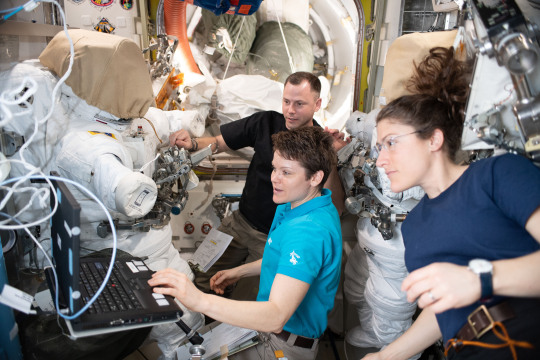
Christina Koch (pictured on the right) becomes the most recent woman in space, launching to the space station in mid-March to take part in some 250 research investigations and technology demonstrations. Koch served as station chief of the American Samoa Observatory and has contributed to the development of instruments used to study radiation particles for the Juno mission and the Van Allen Probe.
Anne McClain, Expedition 57/58, 59

Flight Engineer Anne McClain collects samples for Marrow, a long-term investigation into the negative effects of microgravity on the bone marrow and blood cells it produces. The investigation may lead to development of strategies to help prevent these effects in future space explorers, as well as people on Earth who experience prolonged bed rest. McClain holds the rank of Lieutenant Colonel as an Army Aviator, with more than 2,000 flight hours in 20 different aircraft.
Serena M. Auñón-Chancellor, Expedition 56/57
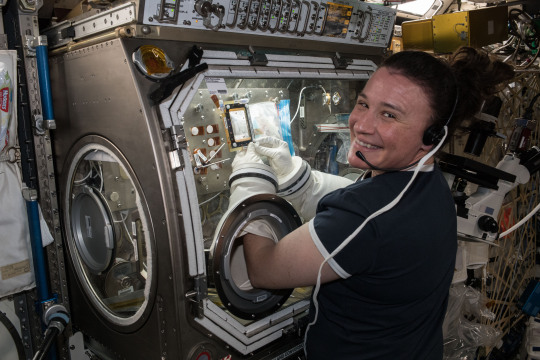
Serena Auñón-Chancellor conducts research operations for the AngieX Cancer Therapy inside the Microgravity Science Glovebox (MSG). This research may facilitate a cost-effective drug testing method and help develop safer and more effective vascular-targeted treatments. As a NASA Flight Surgeon, Auñón-Chancellor spent more than nine months in Russia supporting medical operations for International Space Station crew members.
Peggy Whitson, Expeditions 5, 16, 50, 51/52
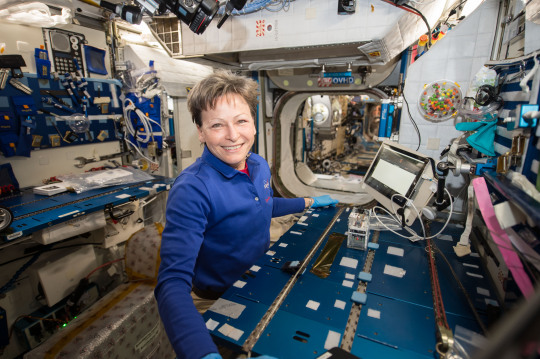
Astronaut Peggy Whitson holds numerous spaceflight records, including the U.S. record for cumulative time in space – 665 days – and the longest time for a woman in space during a single mission, 289 days. She has tied the record for the most spacewalks for any U.S. astronaut and holds the record for the most spacewalk time for female space travelers. She also served as the first science officer aboard the space station and the first woman to be station commander on two different missions. During her time on Earth, she also is the only woman to serve as chief of the astronaut office. Here she works on the Genes in Space-3 experiment, which completed the first-ever sample-to-sequence process entirely aboard the International Space Station. This innovation makes it possible to identify microbes in real time without having to send samples back to Earth, a revolutionary step for microbiology and space exploration.
Kate Rubins, Expedition 48/49

The Heart Cells investigation studies the human heart, specifically how heart muscle tissue contracts, grows and changes its gene expression in microgravity and how those changes vary between subjects. In this image, NASA astronaut Kate Rubins conducts experiment operations in the U.S. National Laboratory. Rubins also successfully sequenced DNA in microgravity for the first time as part of the Biomolecule Sequencer experiment.
Samantha Cristoforetti, Expedition 42/43
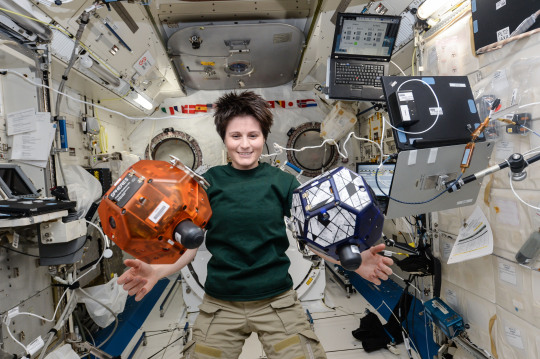
The first Italian woman in space, European Space Agency (ESA) astronaut Samantha Cristoforetti conducts the SPHERES-Vertigo investigation in the Japanese Experiment Module (JEM). The investigation uses free-flying satellites to demonstrate and test technologies for visual inspection and navigation in a complex environment.
Elena Serova, Expedition 41/42

Cosmonaut Elena Serova, the first Russian woman to visit the space station, works with the bioscience experiment ASEPTIC in the Russian Glavboks (Glovebox). The investigation assessed the reliability and efficiency of methods and equipment for assuring aseptic or sterile conditions for biological investigations performed on the space station.
Karen Nyberg, Expedition 36/37

NASA astronaut Karen Nyberg sets up the Multi-Purpose Small Payload Rack (MSPR) fluorescence microscope in the space station’s Kibo laboratory. The MSPR has two workspaces and a table used for a wide variety of microgravity science investigations and educational activities.
Sunita Williams, Expeditions 32/33, 14/15
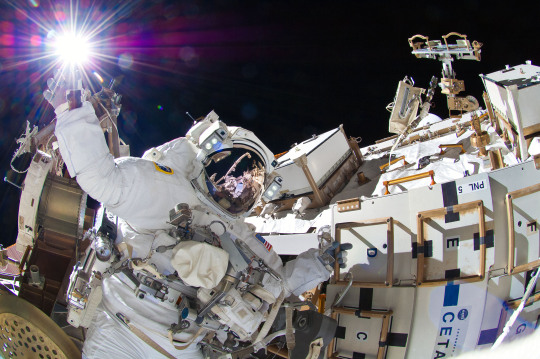
This spacewalk by NASA astronaut Sunita Williams and Japan Aerospace Exploration Agency (JAXA) astronaut Aki Hoshide, reflected in Williams’ helmet visor, lasted six hours and 28 minutes. They completed installation of a main bus switching unit (MBSU) and installed a camera on the International Space Station’s robotic Canadarm2. Williams participated in seven spacewalks and was the second woman ever to be commander of the space station. She also is the only person ever to have run a marathon while in space. She flew in both the space shuttle and Soyuz, and her next assignment is to fly a new spacecraft: the Boeing CST-100 Starliner during its first operational mission for NASA’s Commercial Crew Program.
Cady Coleman, Expeditions 26/27
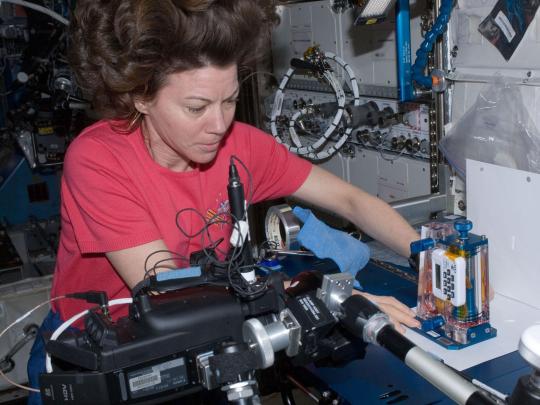
Working on the Capillary Flow Experiment (CFE), NASA astronaut Catherine (Cady) Coleman performs a Corner Flow 2 (ICF-2) test. CFE observes the flow of fluid in microgravity, in particular capillary or wicking behavior. As a participant in physiological and equipment studies for the Armstrong Aeromedical Laboratory, she set several endurance and tolerance records. Coleman logged more than 4,330 total hours in space aboard the Space Shuttle Columbia and the space station.
Tracy Caldwell Dyson, Expedition 24

A system to purify water for use in intravenous administration of saline would make it possible to better treat ill or injured crew members on future long-duration space missions. The IVGEN investigation demonstrates hardware to provide that capability. Tracy Caldwell Dyson sets up the experiment hardware in the station’s Microgravity Science Glovebox (MSG). As noted above, she and Shannon Walker were part of the first space station crew with more than one woman.
Shannon Walker, Expedition 24/25
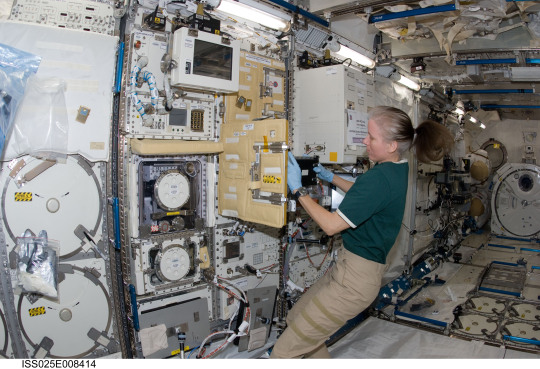
Astronaut Shannon Walker flew on Expedition 24/25, a long-duration mission that lasted 163 days. Here she works at the Cell Biology Experiment Facility (CBEF), an incubator with an artificial gravity generator used in various life science experiments, such as cultivating cells and plants on the space station. She began working in the space station program in the area of robotics integration, worked on avionics integration and on-orbit integrated problem-solving for the space station in Russia, and served as deputy and then acting manager of the On-Orbit Engineering Office at NASA prior to selection as an astronaut candidate.
Stephanie Wilson, STS-120, STS-121, STS-131
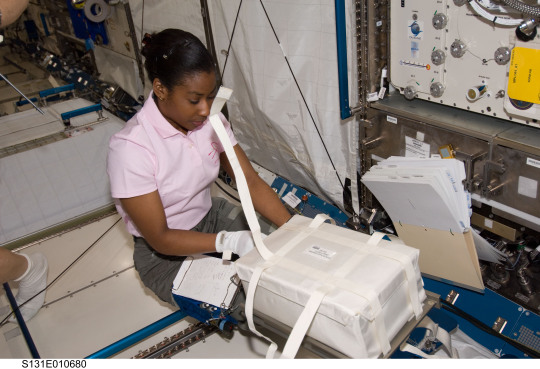
Astronaut Stephanie Wilson unpacks a Microgravity Experiment Research Locker Incubator II (MERLIN) in the Japanese Experiment Module (JEM). Part of the Cold Stowage Fleet of hardware, MERLIN provides a thermally controlled environment for scientific experiments and cold stowage for transporting samples to and from the space station. Currently serving as branch chief for crew mission support in the Astronaut Office, Wilson logged more than 42 days in space on three missions on the space shuttle, part of the Space Transportation System (STS).
Other notable firsts:
• Roscosmos cosmonaut Svetlana Savitskaya, the first woman to participate in an extra-vehicular activity (EVA), or spacewalk, on July 25, 1984
• NASA astronaut Susan Helms, the first female crew member aboard the space station, a member of Expedition 2 from March to August 2001
• NASA astronaut Peggy Whitson, the first female ISS Commander, April 2008, during a six-month tour of duty on Expedition 16
• The most women in space at one time (four) happened in 2010, when space shuttle Discovery visited the space station for the STS-131 mission. Discovery’s crew of seven included NASA astronauts Dorothy Metcalf-Lindenburger and Stephanie Wilson and Japan Aerospace Exploration Agency (JAXA) astronaut Naoko Yamazaki. The space station crew of six included NASA astronaut Tracy Caldwell Dyson.
• Susan Helms shares the record for longest single spacewalk, totaling 8 hours 56 minutes with fellow NASA astronaut Jim Voss.
• Expedition 24 marked the first with two women, NASA astronauts Shannon Walker and Tracy Caldwell Dyson, assigned to a space station mission from April to September, 2010
• The 2013 astronaut class is the first with equal numbers of women and men.
• NASA astronaut Anne McClain became the first woman to live aboard the space station as part of two different crews with other women: Serena Auñón-Chancellor in December 2018 and currently in orbit with Christina Koch.
Make sure to follow us on Tumblr for your regular dose of space: http://nasa.tumblr.com
#women#womenshistorymonth#astronauts#stem#science#space#international space station#NASA#girlpower#Spacewalk#engineering
5K notes
·
View notes
Text
A Natural History of Tatooine, part 13/?
In which Luke ponders his reflection, lamentable world-building choices are lampshaded, and Tor has an opportunity to use her permits.
(Previous installments)
Back in the 'fresher after their sparring, Luke surveyed his face in the mirror, unsettled by what he saw there. He'd always felt older than he looked after his ordeal on Cloud City, but his week on the <i>Eye of Palpatine</i> had aged him more than he liked to admit. The bruises had vanished after a few weeks, the medical droids had removed the shrapnel edges, and Cilghal had thoughtfully erased the scars, but there were lines and subtle wrinkles around the edges of his face that hadn't been there before. And every pain and grief he had experienced in the last decade was present in his eyes; whether he was aware of it or not in the moment, he carried those experiences with him.
<i>When nine hundred years you reach, look this good you will not!</i> Yoda had chided Luke on his deathbed. Studying his reflection now, Luke had to agree his old teacher had had a point.
Since Callista left--just before the start of the practice period--he'd been too wrapped in a dull stupor to bother with shaving. Over those weeks, he hadn't managed to grow anything more than a few inches of ragged stubble across his jawbone. The grizzled hermit beard had suited Ben Kenobi well enough, but didn't suit Luke at all. He made a face and shaved, careful not to cut himself in the process.
With the beard gone, he looked and felt more like his old self, the happy-go-lucky kid who had traipsed off with Obi-wan to the stars, eager for adventure. It wasn't enough to completely restore him, but it was a start.
What had Tor said to him last night? Something about how the vast emptiness of interstellar space was less terrifying than the empty places inside his own mind and heart. Yes, that sounded about right. Right now, Luke found drifting in space to be infinitely preferable to examining the past--except that his thoughts always circled back to the worst moments, round and round in an endless slurry of guilt and self-blame.
He'd been through so much pain and suffering in his life thus far. So many battles, so many enemies, so many losses, so many failures: Owen and Beru slaughtered, his right hand hacked off at the wrist, nearly falling to the Dark Side goaded by Emperor Palpatine's taunts. He'd lost his father, only to regain him moments before he died, too late to truly know him. There was Dev Sibwarra's death at the hands of the Ssi-ruuvi, and that disaster at Mindor, where he'd been forced to kill to save his own life and the lives of billions.
As a teacher, he had not fared much better. He'd almost lost Kyp to the dark side, and three of his Jedi students were now dead. He thought he'd lost Callista, only to have her miraculously reborn in Cray's body--only to lose her again. And now Mara was gone, too--
This must have been how Ben felt when he went into exile, Luke thought. Everyone he knew gone, slaughtered by his own student. How his failures must have eaten at him, every day, alone in the desert. How comforting the desert must have been for him in those dark early days when the Empire was rising.
The desert was a good place to go when you were empty.
Luke had grown up listening to the desert: the howling sandstorms that lasted for days, the dull swish of the dune sand shifting under his feet, the clatter of pebbles falling from the canyon edges into the depths below. Inevitably, the sounds always faded, revealing the implacable silence underneath, the silence that had endured forever and would outlast time. In the stillness, his thoughts rang loud and clear, echoed by the silent voice of the desert that proclaimed his emptiness.
In adolescence, he had rebelled against that desolate, unbearable feeling of isolation. He'd always strived to be someone, someone grand and important, accomplishing great things. He'd stood on the edge of the desert, watching the sunset, his heart aching, swearing he would make something with his life, move beyond the empty wasteland that had dominated his life thus far.
He had succeeded beyond his wildest dreams. He'd saved the galaxy several times over, played a pivotal role in the defeat of the Empire, gained the power to manipulate minds and matter beyond the ken of ordinary folk. Yet--here he was, lonely and defeated, grappling again with the weight of his own failures. Empty.
And he wasn't alone. Tor was here with him. She might be annoying as hell, but at least she wouldn't abandon him. And she wasn't afraid of emptiness. It was a fundamental tenet of her sect, after all.
"Form does not differ from emptiness," she'd said. "Emptiness does not differ from form. Feelings, perceptions, formations are also like this. Vast emptiness--nothing holy, and yet everything holy."
For Tor, form and emptiness were simultaneously the same thing and complete opposites. It was a paradox Luke didn't understand--one that Tor insisted <i>couldn't</i> be understood by reason, it could only be experienced as a fundamental paradox of reality.
"<i>Do or do not. There is no try,</i>" Yoda had insisted. Luke had taken it to mean that he should plunge himself wholeheartedly into the task at hand, holding nothing back. But Yoda had always been subtle, and it was increasingly clear that the "do not" was just as important to the old Jedi master as any concrete action--perhaps even more so.
Maybe it's time to make peace with the desert, he thought. Maybe it's time to accept the emptiness--inside and outside--instead of fighting it.
Funny. He thought he'd learned that lesson before, with his father, with his sister, with his students, over and over again. Yet here he was, right back at it again. <i>Round and round I go, over and over again, until the lesson sinks in, one that might take me my whole life to learn.</i>
And yet--and yet--if there was one thing Luke had learned from his father Anakin Skywalker, it was that it was never too late to let go of hate, fear, and aggression, and embrace love and acceptance.
It wouldn't be easy. If it were easy, he would have already done it. And yet--
He would go back to the desert, and he would see what it had to offer him now. He would listen to the silence, and let himself be empty. And perhaps, out of that vast space, a new direction would emerge.
***
"Ah, good," said Tor, upon his entrance to the conservatory a few minutes later. "I meant to warn you about the starving jenka cat attacking your face, but you seem to have dealt with it very handily. My congratulations."
Luke brushed aside a plume of purple orchids and sat down by the holo-table. "I take it I meet with your approval now."
"Well, if 'cult leader of questionable mental stability' was the look you were aiming for earlier, you nailed it," Tor said as she spritzed a series of green tufts with no discernable roots that were dangling from hooks in the ceiling. "I much prefer this version of Luke Skywalker, myself."
"Duly noted," Luke said dryly. "How do those plants survive floating in mid-air like that?"
"These are Miraki air-plants," Tor said. "As the name suggests, they take water and moisture through their leaves - sort of like mini vaporators, except they horde the water for themselves," Tor said. "In the wild, they form dense colonies on top of anything that will sit still for long enough--including some of the dumber herbivores--but I've had trouble adapting them to the altered humidity levels aboard ship. Their growth is tied in to the direction of the local magnetic fields, and they express their resentment of the fluctuating levels here by developing brown rot and expiring."
"That's--very strange."
Tor shrugged. "As you may have noticed, the galaxy is a strange place. Most people find that troubling, so they do their best not to look too hard. But you'll find oddities like these air-plants anywhere you go."
"Not on Tatooine," Luke said firmly.
"On the contrary. The <i>Galactic Field Guide to the Outer Rim Territories, Volume Six</i> claims that there are no plants on Tatooine at all. If that's true, what do wild banthas eat?"
Luke frowned. "I guess that depends on what you mean by 'plant'. There are certainly some plant-like things out there in the dunes and canyons, and plenty of desert lichen and salt-flat algae in shadier spots. I always assumed that banthas ate them."
"A reasonable assumption," Tor agreed. "But banthas are <i>big</i>--several hundred pounds at a minimum. How much lichen would a single bantha have to consume each day just to stay alive? Is that really sustainable?"
He saw where she was going with this. "So how do they do it, then?"
Tor shrugged. "Like I said, the galaxy is a strange place. We know they must do it somehow, because wild bantha populations exist, but we have no idea how. That's where people like me come in. We poke around, ask annoying, inconvenient questions, and, if we're lucky, eventually emerge with an explanation ranging from the plausible and obvious to the incredibly bizarre."
"I thought we were looking for non-existent trees, not banthas."
"We are. I'm just using the banthas to prove my point. Every place that supports life is full of these odd, impossible contradictions. Once you start to notice them, they're everywhere. It's one of the things that makes my job so fun."
"And the others?"
"Well, I get to travel to interesting places and meet interesting people. And you never know what's going to happen next--"
"Sounds like being a Jedi then,"
"There is some overlap," Tor agreed. "It's one reason why we get along so well, don't you think?"
"And here I thought it was my personality--"
Luke was cut off by the high-pitched whine of the alarm, informing them that they would be dropping out of hyperspace shortly. Both of them were on their feet and heading for the cockpit, just in time to see the starlines shrink down to single points of light, and the great brown sphere of the planet out of the central viewports.
"Do you want me to land at the spaceport in Mos Eisley?" Luke asked, as he strapped himself into the pilot's chair without asking Tor for permission.
"Do I <i>look</i> like an idiot?" Tor said, sliding herself into the co-pilot's chair beside him. If Luke's usurpation of her rightful place bothered her, she didn't comment.
"...No."
"Take us in closer and I'll put in the coordinates of where I'm aiming for," Tor said. "This is going to be fun."
***
Halfway through their descent into the atmosphere, the comm crackled. "Unidentified ship, please state your name and business," a grim voice declared in heavily accented but intelligible Basic.
"False IDs are right there," Tor whispered, pointing to a dial on Luke's right. She turned to the comm. "This is the <i>Chvantha Maru</i>, on a routine survey mission for the Independent Academic Explorer's Corps."
"Negative," said the controller. "Alter your present course to land at Mos Eisley spaceport and communicate with proper authorities."
"I don't think you understand," Tor said. "We have no business in Mos Eisley. We're here for aerial surveys and will land only in the event of an emergency. Besides, we have permits."
"All permits must be submitted through the proper channels," said the controller, with obvious skepticism. "No such permits have been received."
"Right here," Tor whispered to Luke with a grin. "I got them all ready right here."
Luke raised an eyebrow, but transmitted the permits. They kept descending.
"<i>Chvantha Maru</i> if that's really your name," sputtered the comm a few minutes later. "Permits denied. Alter your course to Mos Eisley spaceport or be destroyed."
"How rude!" Tor remarked under her breath. "I thought you said nobody cared if we landed on this dustball?"
"Well-- things must have changed," Luke said. "Last time I was here, we came in at night behind the moons to avoid stirring up any Imperial or Hutt presence. If anyone saw us, they assumed we were smugglers and left us alone."
"Did you not read the permits I sent you?" Tor said into the microphone. "What part of 'Don't even bother trying to stop me' did you not understand? Did I use the wrong verb?"
"You still want to bribe them?" Luke asked under his breath.
Tor snorted. "I'll save my credits, thank you very much. These guys are all talk--"
"<i>Chvantha Maru</i>, this is your last chance. Alter your course, or be destroyed--"
"Oh, I don't know about that," Luke said, pointed to the dashboard, where at least five fighters were barreling towards them. "The markings are all wrong for the planetary government. Those look like Hutt ships to me."
"I see them, I see them," Tor said. "Can you evade them?"
Luke studied the approaching vessels as he pondered his options. The whole situation was completely absurd. He was a Jedi Knight, a distinguished ex-general in the New Republic military, traveling under false IDs to a backwards planet for questionable ends. Leia would be upset if he triggered a diplomatic incident, assuming word of this clandestine expedition ever got back to her.
He hadn't fought or flown in a starship battle in <i>years</i>.
He looked down towards the sandy wastes that stretched out below them in endless waves, then back at the coordinates Tor had fed the <i>Destiny</i>'s navicomputer. If they maintained their present course, they'd be directly over the territory that Luke had spent his adolescence exploring, poking about every nook and cranny until he'd known like the back of his hand.
And in a sudden burst of insight, he knew exactly what he needed to do to win. <i>Without</i> hurting anyone in the process.
Unless they weren't good pilots, in which case they deserved what they got if they were crazy enough to follow him--
"Strap in, and hold tight," Luke said, a wide grin stretching across his face as he embraced the full audacity of his plan. "I have an idea."
3 notes
·
View notes
Text
Episode Reviews - Star Trek The Next Generation Season 1 (4 of 6)
Ok, loyal readers, one last round of reviews for season 1 of Star Trek TNG while we’re still in January, and then the rest can be left to next month. Without further ado, here’s my look at episodes 15 to 19 of that season…
Episode 15: 11001001
Plot (as adapted from Wikipedia):
The Federation starship Enterprise arrives at Starbase 74 for a routine maintenance check. Captain Jean-Luc Picard and Commander William Riker greet Starbase Commander Quinteros and two pairs of small humanoid aliens known as Bynars; the Bynars heavily rely on their computer technology and work in pairs for best efficiency. Much of the crew take shore leave while Picard, Riker and a skeleton crew remain aboard. Riker is intrigued by the Bynars' claimed upgrades to the holodeck and starts a program in a jazz bar. The program includes a woman named Minuet, by whom Riker is fascinated, both as a beautiful and charming woman, but also by the level of sophistication in her responses. Riker is soon enthralled by the program, and Picard later walks in on him kissing Minuet, and he too is amazed by the simulation.
Meanwhile, a catastrophic containment failure is detected in the ship's warp core. Lt. Cmdr. Data and Lt. Geordi La Forge are unable to locate Picard or Riker and, assuming them to already be on the Starbase, order an emergency evacuation. They set the ship to leave the Starbase and warp to a safe location before it would explode. However, once they are clear of the dock, the failure disappears and the ship sets course for the Bynar system, the planet Bynaus orbiting Beta Magellan. Data, La Forge, and Quinteros realize that the Bynars are still aboard the ship, but there are currently no other working vessels to follow them. Back on the Enterprise, Riker and Picard leave the simulation to find the ship empty and at warp to the Bynar system, with the ship's controls locked to the bridge. Fearing that the Bynars have taken over the ship for nefarious purposes, they set the ship to self-destruct in 5 minutes and then take the bridge by intra-ship transporter beam and find the Bynars there unconscious.
After cancelling the self-destruct, they find the Bynars have uploaded massive amounts of information to the Enterprise computers, but they are unable to decode it. Realizing that Minuet was purposely created by the Bynars to distract them, Picard and Riker ask the simulation about what is going on as the ship nears the orbit of Bynaus. Minuet explains that a star near the Bynar homeworld had gone supernova, and the EMP it emitted would knock out their computer systems, effectively killing the Bynars. They had used the Enterprise to upload their computer information for safekeeping and then planned to download it back to the Bynar computers after the threat of the EMP had passed. With Data's help, Picard and Riker successfully download the data, and the Bynars recover. They apologize for their actions, having feared that Starfleet would refuse to help, though Picard notes they only had to ask. As the Enterprise returns to Starbase 74, Riker returns to the holodeck to thank Minuet but finds that without the Bynar data, the simulation has regressed to the expected norm for the holodeck, and while Minuet still exists, she is not the same as before. Riker reports to Picard that Minuet is gone.
Review:
This episode could be one of the best of the first season of TNG, if it knew what to be. First, we get the Bynars, who are an interesting concept along the lines of human-machine interface and the general concept of cyborg races, but that isn’t explored to any great degree. Next, we get another advancement in holodeck characters in the form of Minuet, who displays an incredible degree of awareness and interactivity that would pave the way for audiences to buy into characters in later Trek like TNG’s sentient Moriarty programme, DS9’s Vic Fontaine and the Fair Haven townspeople on Voyager.
However, the Bynar plot elements prevent us from exploring fully just how realistic Minuet was. In essence, the two plots interrupt each other for a random starship heist that comes out of the proverbial blue. It is interesting, however, to see Data reproaching himself for being busy with exploring the idea of creativity in his quarters when the ship gets into trouble. It’s a remarkably human trait for Data to have at this stage in his character arc, and is a testament to Spiner’s ability to play the character so well that it doesn’t feel out of place.
That said, Riker’s comment about ‘a blind man teaching an android how to paint’ being ‘worth a page or two in somebody’s book’ feels a little dismissive towards those who are differently abled. Given that Geordi can see in his own way, his visor being just a sci-fi metaphor for how the blind simply rely more on their other senses in real life, I see nothing remarkable about him being the one to teach Data about art. Art is not about your senses or even your hands; it comes from the heart and mind, from who a person is, and their desire to express a feeling or idea. People who are blind are no more or less capable of producing art than those who are sighted; they just have to pick a medium that works for them, same as any artist does. Overall, I give this episode about 6 out of 10.
Episode 16: Too Short A Season
Plot (as adapted from Wikipedia):
The Enterprise, under the command of Captain Jean-Luc Picard, brings aboard the elderly Admiral Mark Jameson and his wife Anne on request of Karnas, the Governor of Mordan IV. Karnas warns that a dissident terrorist group has taken a Federation Ambassador and his staff hostage, and demand to speak to a Federation negotiator. Jameson had negotiated a previous settlement on Mordan IV. As the ship travels to Mordan IV, Jameson becomes stronger and more able to move about on his own, and no longer shows signs of the incurable Iverson's Disease he was known to have before he was beamed aboard. Jameson admits to taking an array of drugs to reverse the aging process over the last two years, and only recently has taken an overdose of the drugs to prepare himself for the negotiations. Jameson begins to appear younger and full of energy, but has frequent pains as a result of the overdose. By the time they are nearing Mordan, Jameson appears as a young adult.
As they approach the planet, Jameson begins communication with Karnas to learn more of the situation, but soon intuits that it is Karnas himself that has taken the Federation staff. Karnas reminds Jameson that his treachery during their last encounter on Mordan IV resulted in years of war. Against the advice of Picard, Jameson devises plans to rescue the hostages by transporting the away team to the tunnels beneath Karnas' mansion, where Jameson believes the hostages are being held. Picard privately confronts Jameson about Karnas' motives. Jameson reveals that in the past, Karnas captured a Federation starliner in revenge for the death of his father by another local tribe. Jameson negotiated for the passengers' release by giving Karnas what he demanded, a supply of Federation weapons. However, Jameson, in his interpretation of the Prime Directive, also supplied the warring tribes with the same weapons to keep all sides in the conflict on even terms. Jameson had thought this would only lead to a short-lived skirmish, and had not expected a war that would last over forty years. Jameson is now insistent on correcting his past mistake and thus took the reverse aging drug in order to be at his best.
In orbit, the Enterprise crew and Jameson beam down into the tunnels beneath Karnas' manor, but find that their arrival was anticipated and face off against armed guards. Jameson collapses during the fight, and the crew beams back to the Enterprise. Jameson was not shot, but the reverse aging drug is destroying his body. Karnas demands to see Jameson or he will kill a hostage every 15 minutes. Picard opts to beam himself, Dr Crusher, Jameson, and eventually Jameson's wife Anne directly to Karnas' office. Karnas refuses to believe that the young man is Jameson, so Jameson reveals a scar on his wrist inflicted by Karnas years ago. Jameson dies shortly afterward in his wife's embrace. Karnas agrees to let the hostages go, and to allow Jameson to be buried on Mordan IV at Anne's request.
Review:
This is another example of TNG getting a decent premise for an episode and then bottling the execution, which as we’ve seen from all my reviews up to this point was par for the course on the first season. The idea of a proverbial “fountain of youth” isn’t really explored in any depth or detail, making any argument the episode might be making against fighting the process of aging inaudible. The episode would have been better served by chucking that story out and putting more time into the guest character of Admiral Jameson turning out to be a dirty Star Fleet officer. The idea that a Star Fleet officer might really cross the line with the Prime Directive seems far more interesting, as it would have added a little more realism to Roddenbery’s ideal of the future that Trek is supposed to be.
Sadly, like many reviewers, I find that the episode is too focused on Jameson over both story ideas that the main cast are virtually demoted to extras, and this is made even worse by the guest actor somewhat over-playing the scenes where he’s an old man. Overall, the episode ends up as just filler on the way to better episodes later on the series as a whole. I’d give this one about 3 out of 10.
Episode 17: When The Bough Breaks
Plot (as adapted from Wikipedia):
The Enterprise enters the Epsilon Mynos system, searching for the legendary world of Aldea. The planet de-cloaks, and reveals itself to the ship. The Aldeans beam down Commander William Riker, Counsellor Deanna Troi, and Chief Medical Officer Beverly Crusher to the planet. The Aldeans explain that they have been unable to bear children for many years and revealed themselves to the Enterprise in hopes they could trade their advanced technology for some of the Enterprise's children so that they can re-populate their world. Riker refuses and the crew are returned to the Enterprise. Simultaneously, seven children, including young Wesley Crusher, are taken down to the planet protected by a planetary energy shield that the crew of the Enterprise are unable to penetrate. While the Aldean elders attempt to integrate the children into their society, Wesley is shown the "Custodian", an ancient computer system that the Aldeans rely on but do not understand.
As Captain Jean-Luc Picard attempts to negotiate with the Aldeans, they briefly allow Dr Crusher to reunite with her son on the planet. Wesley hints about the Custodian to her, while she secretly passes him a tricorder to scan the Aldeans. After Picard fails to get the Aldeans to agree to the children's return, they fire an energy weapon that sends the Enterprise three days away from Aldea at maximum warp. The Aldeans warn that they can send the Enterprise an impossibly far distance if they refuse to cooperate. During the return trip, Dr Crusher reviews the scanner results and finds the Aldeans are suffering from radiation poisoning, which has harmed their reproductive capabilities but can be reversed if the source is discovered. On arrival back at the planet, Picard orders the crew to try to find a way through the planet's shield while he restarts negotiations.
Wesley, aware the Enterprise is in orbit, arranges for the children to passively resist. When the Aldeans request Picard's help to resolve the issue with the children, the crew finds a way to beam through the shield, allowing Commander Riker and Lt. Commander Data to sneak onto the planet. Data manages to disable the Custodian, disrupting the Aldean's transporter and planetary shield. Dr Crusher explains to the Aldeans that their shield has weakened the ozone layer of their planet, exposing the inhabitants to ultraviolet radiation that has left them unable to bear children. The radiation would likely have the same effects on the children from the Enterprise. Without the planetary shield, the ozone layer will naturally return, allowing the Aldeans to reproduce again. The Aldeans recognize the error of their ways and return the children to the Enterprise. They accept Starfleet's help to correct their ancient systems and recognize that they will have to forgo their invisibility to continue their society.
Review:
While some reviewers have apparently disliked this episode for its point about how humans at the time of the show, and still today, mess up the ozone layer being unsubtle, I disagree. Unlike the people of the Star Trek universe, real world humanity can’t just pick up and warp off to another life-sustaining world if we muck our own planet up beyond even the possibility of repair. As such, any form of fiction that’s trying to press this point should never be subtle. It has to press it home, hard, and if needs be it needs to hammer an audience about the head with the point until it sticks, and let’s face it, the idea that ozone depletion could cause mass infertility and drive a society into becoming child snatchers is an interesting take on the idea.
The problem this episode suffers, however, is that the Aldeans so effectively keep the Enterprise crew on the back foot that they aren’t able to provide the level of visceral response a plot like this needs. Picard’s initial verbal outrage is about as good as we get in terms of any primal response from the Federation adults, and the children don’t display the level of resistance they should considering they’ve been effectively kidnapped. Franchises like CSI or NCIS do better in this line, especially with regards to rescuing the children and punishing their abductors.
I don’t care what the excuse is for the Aldean’s behaviour; Picard should have had Riker and Data take down the shield around Aldea, beamed all his people back to the Enterprise and fired a spread of photon torpedoes down from orbit as a punitive measure. The idea that there’s no real reprisal for the Aldeans for being a bunch of heartless child abductors is what makes me really dislike this episode. If letting such barbarism and criminality go unpunished is what the utopian future of Trek demands, then I think we need to stop just short of that future and never, ever realise it completely.
All that said, we get one of the better performances so far from Wil Wheaton as Wesley, and Picard is decidedly improved in terms of how he behaves around children. However, the lack of a phaser-heavy resolution to the child abduction aspect of the story means I can’t see this as a good episode at all. The few plus points of the episode only get it up to a score of 3 out of 10.
Episode 18: Home Soil
Plot (as adapted from Wikipedia):
Diverted from exploring the Pleiades, the Enterprise arrives at the terraforming colony on Velara III, as the project is behind schedule. The director, Kurt Mandl, insists they are on time but Captain Jean-Luc Picard orders an away team to the surface after Counsellor Deanna Troi senses that Mandl is hiding something. After they arrive, one of Mandl's team is killed by a malfunctioning laser drill. During Lt. Commander Data's inspection of the tool, it begins to fire at him, but his quick android reflexes allow him to dodge the shot and render the drill harmless. He finds the programming of the laser was rewritten to fire upon the staff. Nearby, a crystal is discovered giving off irregular light and radiation patterns. The crystal is brought aboard the Enterprise to study and Picard orders a halt to the terraforming.
Dr Beverly Crusher and Data discover the crystal may be alive. When the crystal attempts to interact with the Enterprise's computers, it is placed into a containment force field. The crystal begins to grow and gains access to the computer's translation program and attempts to communicate with the crew, treating the humans as an enemy, derisively calling them "ugly bags of mostly water". Picard discovers that Mandl and his team previously encountered the crystals; at the time, they knew about light patterns coming from them, but never considered the possibility that the crystals were alive. The terraformers used a drilling process responsible for removing the saline water layer from the water table of Velara III. This saline layer acted as a conductor, allowing many separate crystals to function as one life form. In a defensive response to the drilling, the crystal life form rewrote the laser's software and attacked the terraformers.
Data hypothesizes that a single crystal is not intelligent, but when linked to other crystals, their intelligence is formidable. As the crystalline life form accesses higher-level functions of the Enterprise's computer, Picard and the crew try to transport it to the surface but the crystal blocks all attempts to transport it off the ship. Data and Lt. Geordi La Forge discover the presence of cadmium in the crystal and suspect it has photoelectric properties. They disable the lights in the medical lab and the crystal immediately begs for life. Picard peacefully negotiates to return the crystal life form to the surface of the planet where Starfleet will institute a quarantine, leaving the life form to live in peace.
Review:
This episode is a quite bland and largely forgettable enterprise (pardon the pun) by those who made this series. Other reviewers have apparently noted a similarity to the original series of Star Trek, but as someone whose fandom of Trek is primarily related to the Picard-Sisko-Janeway era and only enjoys Kirk’s crew in their rebooted film format, I’m not about to go looking into that. Instead, I look at the episode itself, which falls flat about halfway through.
The area where the episode falls apart is right around the time we start going into the idea of an inorganic crystalline structure being alive. Up until that point, the way the terraformers acted, one of them dying and Data then almost going the same way all seemed to point to one thing; a possible murder-mystery, and with Data’s fascination with Sherlock Holmes and Picard’s affinity for Dixon Hill, we could have had a great mystery story. Instead, we go full-tilt into a very sci-fi plot that doesn’t reveal much of a point plot-wise. Granted, the metaphor of inorganic life being accidentally destroyed by haste and the desire to play god with one’s environment is good Trek fare, or at least in keeping with general Trek tradition. However, we already saw a crystal-based lifeform back in Datalore, and we just had an eco-friendly message in the episode right before this one. As such, the episode lacks continuity and variation enough to make it anything really good. I’d give it only 4 out of 10.
Episode 19: Coming Of Age
Plot (as adapted from Wikipedia):
Captain Jean-Luc Picard greets his friend Admiral Gregory Quinn and his assistant Lt. Commander Dexter Remmick aboard the Enterprise. For classified reasons, Quinn has ordered Remmick to perform an investigation of the Enterprise and its crew and expects Picard to fully co-operate. Remmick's inquiry causes tension in the crew, particularly when he questions the trustworthiness of the senior staff based on their personal logs and past actions. A young cadet, having failed the Starfleet Academy entrance examination, attempts to run away in a shuttlecraft but ends up drifting. Picard is able to direct the cadet to pilot the shuttle away from a planet by bouncing off the atmosphere.
The investigation is completed, and Remmick informs both Picard and Quinn that there is no sign of wrongdoing, and expresses his interest in joining its crew in the future. Quinn tells Picard that he feels there is an unknown force that may have infiltrated Starfleet, and he was seeking to assure himself of his trust in Picard and the Enterprise crew. To help combat this threat, Quinn offers Picard a promotion to Commandant of Starfleet Academy which would place Picard near Quinn at all times. Picard mulls the offer for some time, but eventually declines.
Meanwhile, Wesley Crusher prepares to take the Academy entrance exam himself. He succeeds in passing several parts of the exam, and helps Mordock, a highly talented Benzite and fellow competitor, to solve a difficult test problem so that they may both advance. Wesley is worried about the psychological part of the exam, and he is directed to a room to wait for the test to start.
While waiting, he hears an explosion nearby, and leaves the room to investigate. He finds two men trapped by fallen components in a fire-engulfed room. Wesley helps to release one man wounded under a heavy pipe, and tries to coax the other man to leave the burning room, but the man is frozen with fear. Wesley is forced to abandon him and drags the other man to safety. Outside the room, he discovers the explosion was fake and this was the psychological test: to see whether he could make a difficult decision (rescuing either man would pass the test).
Eventually, the cadets are told of the results, and Mordock is granted admission into Starfleet Academy, while Wesley is encouraged to try again next year. Mordock thanks Wesley for his help and wishes him future success. After Wesley returns to the Enterprise, Picard confides in him that he also failed the examination the first time.
Review:
Coming Of Age is the first episode of this show that hasn’t been flawed in concept, and actually has two quite decent plots that both work reasonably well. Granted, in terms of the inquisition of the Enterprise crew by Remmick, it does grate in places because characters like Remmick are designed to be abrasive and unlikeable by design. Moreover, it’s good to see some of how Picard and his crew have acted in past episodes called into question, even if the whole thing is only so much smoke and mirrors.
In turn, Wesley’s story was a good one to watch as well, which is remarkable considering how horribly Wesley was being written in much of this show’s early episodes. It’s also interesting to see the two plots interconnecting at the end through Wesley and Picard, and the scene where they talk in the observation lounge near the end is the kind of good quality scene we should have been getting between the pair from earlier on. I know from behind-the-scenes features that to help Patrick Stewart understand his role, Roddenberry cited the Hornblower novel series. As a fan of the TV adaptations of Hornblower done by ITV, I can see that under different circumstances, Picard and Wesley could have become equivalent to Sir Edward Pellew and Hornblower in their relationship. Sadly, it didn’t turn out that way, but I’m glad to finally get a truly decent episode out of this season. I give it 8 out of 10.
0 notes
Photo
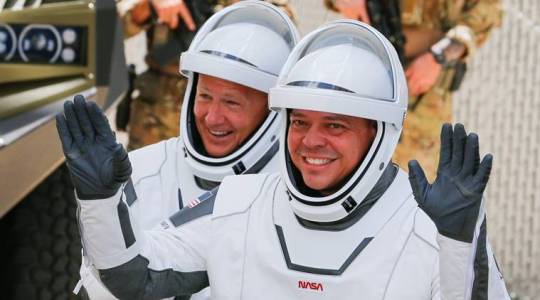
New Post has been published on https://techcrunchapp.com/spacex-crew-dragon-departs-carrying-nasa-astronauts-toward-home/
SpaceX crew Dragon departs, carrying NASA astronauts toward home

By: New York Times |
Published: August 2, 2020 9:16:49 am




NASA astronauts Douglas Hurley and Robert Behnken head to launch pad 39 to board a SpaceX Falcon 9 rocket for a second launch attempt on NASA?s SpaceX Demo-2 mission to the International Space Station from NASA?s Kennedy Space Center in Cape Canaveral, Florida, U.S. May 30, 2020. REUTERS/Joe Skipper
Two astronauts who took the first commercial trip to orbit have left the International Space Station. They are scheduled to return home Sunday.
Astronauts Robert Behnken and Douglas Hurley traveled to the space station in May aboard a Crew Dragon capsule built and run by SpaceX, the private rocket company started by Elon Musk.
The Crew Dragon undocked from the space station at 7:35 p.m. EDT on Saturday, with brief thruster firings pushing the spacecraft back.
As the capsule backed away from the station, Hurley thanked the current crew of the space station and the teams on the ground that helped manage their mission.
“We look forward to splashdown tomorrow,” he said.
If the weather remains favorable, it will splashdown in the Gulf of Mexico off Pensacola, Florida, at 2:41 p.m. Sunday, NASA announced.
A safe return would open up more trips to and from orbit for future astronaut crews, and possibly space tourists, aboard the spacecraft.
Isaias is forecast to sweep up along the Atlantic coast of Florida over the weekend. NASA and SpaceX have seven splashdown sites in the Gulf of Mexico and the Atlantic, but the track of the storm ruled out the three in the Atlantic.
“We have confidence that the teams on the ground are, of course, watching that much more closely than we are,” Behnken said during a news conference Friday, “and we won’t leave the space station without some good landing opportunities in front of us, good splashdown weather in front of us.”
How can I watch the return of the astronauts?
NASA Television’s coverage will continue through splashdown.
What will happen after they leave the station?
A: The capsule is now performing a series of burns to move away from the station and then line up with the splashdown site.
For much of the trip, Behnken and Hurley will be sleeping. Their schedule sets aside a full night of rest.
Any return journey that exceeds six hours has to be long enough for the crew to get some sleep between undocking and splashdown, Daniel Huot, a NASA spokesman, said in an email.
Otherwise, because of the extended process that leads up to undocking, the crew would end up working more than 20 hours straight, “which is not safe for dynamic operations like water splashdown and recovery,” Huot said.
Just before a final burn that will drop the Crew Dragon out of orbit Sunday afternoon, it will jettison the bottom part of the spacecraft, known as the trunk, which will then burn up in the atmosphere.
At reentry, the Crew Dragon will be traveling at about 17,500 mph. Two small parachutes will deploy at an altitude of 18,000 feet when the spacecraft has already been slowed by Earth’s atmosphere to about 350 mph. The four main parachutes deploy at an altitude of about 6,000 feet.
Once the capsule splashes in the water, it is expected to take 45 to 60 minutes to pluck them out.
Why does Isaias affect the return?
The storm complicated where splashdown could take place. At the splashdown site, winds must be less than 10 mph for the capsule to land safely. There are additional constraints on waves, rain and lightning. In addition, helicopters that take part in the recovery of the capsule must be able to fly and land safely.
The first landing opportunity will aim for only the primary site, Pensacola. If weather there is inconsistent with the rules, the capsule and the astronauts will remain in orbit for another day or two, and managers will consider the backup site, which is Panama City, Florida.
Is it safer to land on water or on land?
Spacecraft can safely return to Earth in either environment.
During the 1960s and 1970s, NASA’s Mercury, Gemini and Apollo capsules all splashed down in the ocean while Soviet capsules all ended their trips on land. Russia’s current Soyuz capsules continue to make ground landings, as do China’s astronaut-carrying Shenzhou capsules.
When Boeing’s Starliner capsule begins carrying crews to the space station, it will return on land, in New Mexico. SpaceX had originally planned for the Crew Dragon to do ground landings but decided that water landings, employed for the earlier version of Dragon for taking cargo, simplified the development of the capsule.
Why is the return trip an important part of the Crew Dragon’s first flight?
A: After launch, reentry through Earth’s atmosphere is the second most dangerous phase of spaceflight. Friction of air rushing past will heat the bottom of the capsule to about 3,500 degrees Fahrenheit. A test flight of the Crew Dragon last year successfully splashed down, so engineers know the system works.
A successful conclusion to the trip opens the door to more people flying to space. Some companies have already announced plans to use Crew Dragons to lift wealthy tourists to orbit.
In the past, NASA astronauts launched on spacecraft like the Saturn 5 moon rocket and the space shuttles that NASA itself operated. After the retirement of the space shuttles in 2011, NASA had to rely on Russia, buying seats on the Soyuz capsules for trips to and from orbit.
Under the Obama administration, NASA hired two companies, SpaceX and Boeing, to build spacecraft to take astronauts to the space station. NASA financed much of the work to develop the spacecraft but will now buy rides at fixed prices. For SpaceX, the trip by Behnken and Hurley — the first launch of astronauts from American soil since the last space shuttle flight — was the last major demonstration needed before NASA officially certifies that the Crew Dragon is ready to begin regular flights.
Who are the astronauts?
Behnken and Hurley have been friends and colleagues since both were selected by NASA to be astronauts in 2000.
Both men have backgrounds as military test pilots and each has flown twice before on space shuttle missions, although this is the first time they have worked together on a mission. Hurley flew on the space shuttle’s final mission in 2011.
In 2015, they were among the astronauts chosen to work with Boeing and SpaceX on the commercial space vehicles that the companies were developing. In 2018, they were assigned to the first SpaceX flight.
What have the astronauts been doing aboard the space station?
Originally, the mission was to last only up to two weeks, but Behnken and Hurley ended up with a longer and busier stay at the space station. Because of repeated delays by SpaceX and Boeing, NASA ended up short-handed, with only one astronaut, Christopher J. Cassidy, aboard the space station when the Crew Dragon and its two passengers docked.
They stayed two months, helping Cassidy with space station chores. Behnken and Cassidy performed four spacewalks to complete the installation of new batteries on the space station. Hurley helped by operating the station’s robotic arm.
The men have also been contributing to science experiments in low earth orbit. They assisted in a study of water droplet formation in the low gravity environment of the space station using a shower head, and another that used fruit punch and foam to look at how to manage fluids in space. They also helped install new equipment inside the station that will be used in future scientific research.
Cassidy will remain aboard the station with two Russian astronauts, Anatoly Ivanishin and Ivan Vagner. All three are to stay on board through October when another crew of one American and two Russian astronauts will replace them.
When are the next Crew Dragon flights, and who will they carry?
A: The first operational flight of the Crew Dragon will launch no earlier than late September. It will take three NASA astronauts — Michael S. Hopkins, Victor J. Glover and Shannon Walker — and one Japanese astronaut, Soichi Noguchi, to the space station.
The second operational flight, tentatively scheduled for February 2021, will carry two NASA astronauts, Robert S. Kimbrough and K. Megan McArthur; Akihiko Hoshide of Japan; and Thomas Pesquet of the European Space Agency.
📣 The Indian Express is now on Telegram. Click here to join our channel (@indianexpress) and stay updated with the latest headlines
For all the latest Technology News, download Indian Express App.
0 notes
Photo

New Post has been published on https://toldnews.com/world/spacex-dragon-demo-capsule-leaves-station-for-earth/
SpaceX Dragon demo capsule leaves station for Earth
Image copyright
NASA
Image caption
The Dragon capsule backs away from the station to set course for home
America’s new commercial astronaut capsule will complete its demonstration flight on Friday with a splashdown in the Atlantic Ocean.
The SpaceX Dragon vehicle has left the International Space Station (ISS) where it’s been docked this past week to begin the journey back.
It has a heat-shield to protect it from the high temperatures of re-entry.
Four parachutes should bring it into soft contact with water about 450km from Cape Canaveral, Florida.
Splashdown is expected at about 08:45 EST (13:45 GMT). A boat, called GO Searcher, will be waiting to recover the capsule.
Media playback is unsupported on your device
Media captionISS astronaut Anne McClain went inside the Dragon capsule
The mission – which has no humans aboard, only a dummy covered in sensors – has gone according to the script so far.
Assuming the Dragon performs equally well in the coming hours, it will set the stage for the US space agency (Nasa) to approve the vehicle for crewed flights.
The first of these could occur as soon as July, although no-one should be surprised if this target date slips into the summer as engineers work through the post-flight analysis.
For the Dragon’s owner, SpaceX chief executive Elon Musk, there is still much to be accomplished on the existing mission, however.
He’s expressed some anxiety about how the capsule will cope with re-entry.
The vehicle’s backshell, or heatshield, has a somewhat irregular shape and this could lead to a roll instability at hypersonic speeds, he warns.
“I think it’s unlikely; we’ve run simulations a thousand times but this is a possibility,” the California-based entrepreneur told reporters at the weekend.
“So, re-entry with the asymmetric backshell; the parachutes are new – will the parachutes deploy correctly and then will the system guide Dragon to the right location and splashdown safely? I’d say hypersonic re-entry is my biggest concern.”
Not since the shuttles has America been able to send its own astronauts into orbit. It’s had to rely instead on Russia and its Soyuz spacecraft.
Nasa hopes to bring this near-eight-year gap in capability to an end with the introduction of two new commercial transportation systems.
As well as SpaceX, the agency has seed-funded Boeing to produce a capsule of its own called the Starliner.
This vehicle is scheduled to have its uncrewed demonstration flight in April or soon after.
Ultimately, Nasa will be purchasing seats in both systems to take its astronauts to the ISS. But the commercial nature of the relationship means the companies will be free also to sell rides to secondary customers.
These will no doubt include the space agencies of other nations, but perhaps some private space companies and individuals too.
Image copyright
NASA
Image caption
The GO Searcher vessel is tasked with picking Dragon crew capsules out of the water
Nasa has already selected its first astronauts to fly aboard a crewed Dragon.
Bob Behnken and Doug Hurley have been busy training with the SpaceX team, learning all about the capsule’s operation and what to do if there is an emergency.
One problem that could occur is a failure of the Dragon’s carrier rocket during the ascent to orbit.
The demonstration capsule’s lift-off last Saturday was picture perfect, but some kind of booster anomaly can never be discounted.
In such a scenario, a Dragon’s powerful thrusters would push it away from the launcher to safety.
Image copyright
NASA
Image caption
Bob Behnken (L) and Doug Hurley (R) will be the first crew to ride a Dragon
SpaceX will practice this very procedure shortly.
The team plans to take the current Dragon after its return and put it on another rocket and launch it out of the Kennedy Space Center. A minute into this flight, a deliberate abort will be commanded.
The timing is significant because it’s when the vehicle is experiencing maximum aerodynamic pressure.
If the Dragon can stably depart in such circumstances, it ought be able to handle an escape at any stage in a flight.
As with the present demo, no-one will be aboard for this hazardous test.
Image copyright
NASA
Image caption
Boeing (near) and SpaceX (far) have a commercial relationship with Nasa
[email protected] and follow me on Twitter: @BBCAmos
0 notes
Text
Iss Astronauts

News
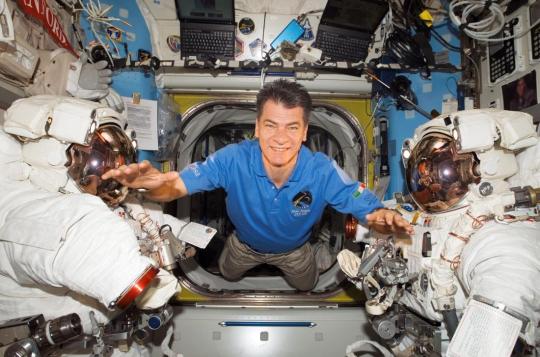
A SpaceX Crew Dragon capsule carrying four astronauts back to Earth from the International Space Station has parachuted into the Gulf of Mexico. It was the first US crew splashdown in darkness since 1968.
The International Space Station (ISS) took 10 years and more than 30 missions to assemble. It is the result of unprecedented scientific and engineering collaboration among five space agencies representing 15 countries. Four astronauts are on their way home from the International Space Station aboard a SpaceX Crew Dragon capsule, ending their five-month mission to the orbiting laboratory. The astronauts set a. The International Space Station was taken into space piece-by-piece and gradually built in orbit using spacewalking astronauts and robotics. Most missions used NASA's space shuttle to carry up the. ISS Astronauts Splash Down Off Florida On SpaceX Craft A SpaceX Crew Dragon capsule carrying four astronauts back to Earth splashed down off Florida early Sunday in NASA's first nighttime ocean. SpaceX capsule with four ISS astronauts splashes down off Florida It was the first US crew splashdown in darkness since 1968. The crew reported they were feeling well after a 6-hour journey in the.
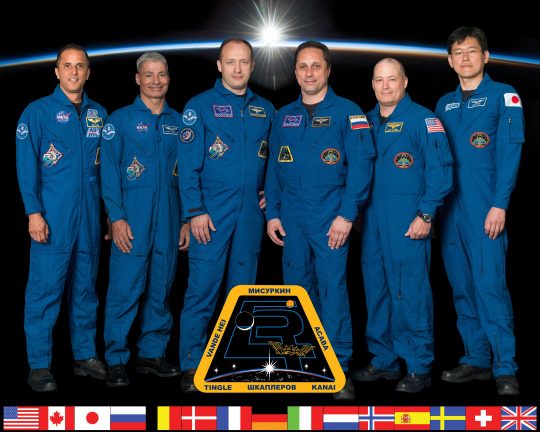
The crew reported they were feeling well after a 6-hour journey in the SpaceX capsule
SpaceX safely returned four astronauts from the International Space Station on Sunday, ending the second astronaut flight for Elon Musk's company.
After an express trip home, lasting just 6 1/2 hours, the crew splashed down in the Gulf of Mexico, off Florida, at around 3 a.m. local time (0700 UTC/GMT).
'Welcome back!'
'We welcome you back to planet Earth and thanks for flying SpaceX,' SpaceX's Mission Control radioed moments after splashdown.
'For those of you enrolled in our frequent flyer program, you've earned 68 million miles on this voyage.'
The landing was the first US nighttime splashdown since Apollo 8's crew returned from the moon in 1968.
The four astronauts had departed the International Space Station (ISS) late Saturday, after more than 160 days in space.
NASA's Mike Hopkins, Victor Glover and Shannon Walker, and Japan's Soichi Noguchi, reached home in the same Dragon capsule that delivered them to the ISS last November.
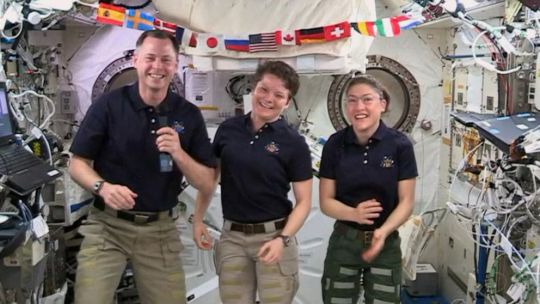
Before the journey, NASA tweeted: 'The astronauts have removed their spacesuits and are enjoying one more meal in space before returning to Earth. They'll suit up again before the deorbit burn, about 4.5 hours from now.'
The Dragon capsule launched SpaceX's first crew last spring
'See you back on Earth'
Current Iss Astronauts
'Thanks for your hospitality,' Hopkins, the spacecraft commander, radioed as the capsule undocked 420 kilometers (260 miles) above Mali. 'We'll see you back on Earth.'
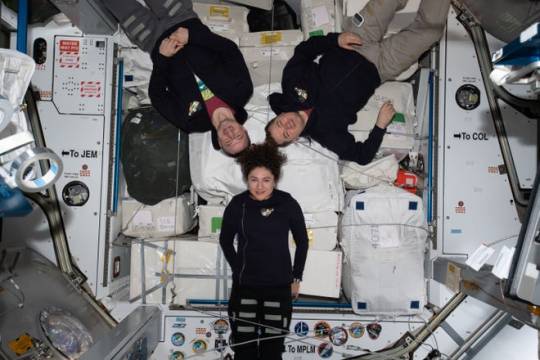
The high offshore wind kept the four at the ISS beyond their original departure date, Wednesday, allowing Glover to celebrate his 45th birthday in space on Friday.
'Gratitude, wonder, connection. I'm full of and motivated by these feelings on my birthday, as my first mission to space comes to an end,' Glover said.
Noguchi tweeted a photo of the crew celebrating Glover's birthday on the ISS with 'live music, yummy cakes, funny videos (and) lots of laughter.'
Iss Astronauts How Long
The four astronauts' replacements arrived a week ago aboard the same Dragon capsule.
Three US astronauts, two Russians, a Japanese and a French national were left at the space station after Saturday's undocking.
Last November, the crew were the first to go on a fully operational mission to the ISS aboard a vehicle made by SpaceX.
SpaceX has become NASA's favored commercial transportation partner, ending nine years of dependence on Russia.
Watch video02:20
Female Iss Astronauts
SpaceX Crew Dragon capsule reaches space station
mm, fb/aw (AFP, AP, dpa)
Having multiple spacecraft going to and from the International Space Station (ISS) is great for scientific progress, but it can cause the occasional traffic jam. Astronauts have executed the first-ever Dragon port relocation maneuver at the ISS, moving one Dragon to a new port, leaving space for the next few capsules to dock at the station.
It’s common practice on the ISS to keep at least one human-rated spacecraft docked at all times. This provides a means of escape for astronauts in the event of a system failure on the ISS or a high risk of impact with space debris. The current escape pod is Resilience, the Dragon capsule that went up to the ISS in November, carrying the first crew members on a regular rotation.
Iss Astronauts Eating Pictures
Resilience remained docked at the forward port on the station’s Harmony module, until 6:30 AM Eastern time on Monday. Four astronauts boarded the vessel and backed it 60 meters away from the station. 38 minutes later, the crew Dragon was docked with the module’s zenith port. This frees up the forward docking port for the next Crew Dragon, which will arrive later this month.
In late April, Resilience will leave the zenith port behind, making its way back to Earth. That will make way for the upcoming cargo Dragon, which will dock at the zenith port in June. Cargo missions need to dock at this location so the station’s robotic arm can unload materials from the trunk compartment on the vehicle.
The Crew-2 launch later this month will bring NASA astronauts Shane Kimbrough and Megan McArthur, ESA astronaut Thomas Pesquet, and JAXA astronaut Akihiko Hoshide to the station. This mission will use the Dragon capsule known as Endeavor, the same one that flew the successful Demo-2 mission in 2020. Crew-1 will splash down on April 28, returning NASA’s Michael Hopkins, Shannon Walker, and Victor Glover, as well as JAXA’s Soichi Noguchi.
Iss Astronauts And Figit Spinner

The ISS will probably only get busier as time goes on. SpaceX is the only commercial spaceflight company with a human-certified vehicle, but Boeing is still plugging away at the CST-100 Starliner. After a flunked uncrewed orbital test in late 2019, Boeing and NASA have decided to re-launch the orbital test this summer. After that, Boeing hopes to have a regular flight to the ISS before the end of the year.
Iss Astronauts Eating
Now read:

1 note
·
View note
Text
Meet Our New Flight Directors!
We just hired six new flight directors to join a unique group of individuals who lead human spaceflights from mission control at our Johnson Space Center in Houston.
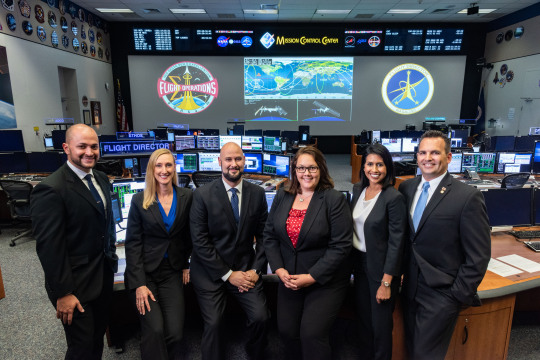
A flight director manages all human spaceflight missions and related test flights, including International Space Station missions, integration of new American-made commercial spacecraft and developing plans for future Orion missions to the Moon and beyond.
Only 97 people have served as flight directors, or are in training to do so, in the 50-plus years of human spaceflight. That’s fewer than the over 300 astronauts!
We talked with the new class about their upcoming transitions, how to keep calm in stressful situations, the importance of human spaceflight and how to best learn from past mistakes. Here’s what they had to say…
Allison Bollinger

Allison is from Lancaster, Ohio and received a BS in Aerospace Engineering from Purdue University. She wanted to work at NASA for as long as she can remember. “I was four-and-a-half when Challenger happened,” she said. “It was my first childhood memory.” Something in her clicked that day. “After, when people asked what I wanted to be when I grew up, I said an astronaut.”
By high school a slight fear of heights, a propensity for motion sickness and an aptitude for engineering shifted her goal a bit. She didn’t want to be an astronaut. “I wanted to train astronauts,” she said. Allison has most recently worked at our Neutral Buoyancy Lab managing the daily operations of the 40-ft-deep pool the astronauts use for spacewalk training! She admits she’ll miss “the smell of chlorine each day. Coming to work at one of the world’s largest pools and training astronauts is an incredible job,” she says. But she’s excited to be back in mission control, where in a previous role she guided astronauts through spacewalks.
She’s had to make some tough calls over the years. So we asked her if she had any tips for when something… isn’t going as planned. She said, “It’s so easy to think the sky is falling. Take a second to take a deep breath, and then you’ll realize it’s not as bad as you thought.”
Adi Boulos
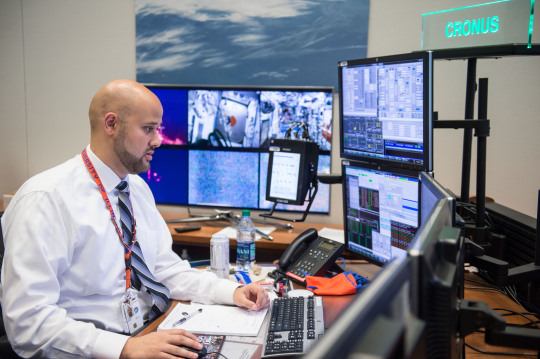
Adi is from Chicago, Illinois and graduated from the University of Illinois Urbana Champaign with a BS in Aerospace Engineering. He joined us in 2008 as a member of the very first group of flight controllers that specialize in data handling and communications and tracking systems aboard the space station.
Most recently he served as the group lead in the Avionics Trainee group, which he loved. “I was managing newer folks just coming to NASA from college and getting to become flight controllers,” he said. “I will miss getting to mentor them from day one.” But he’s excited to start his new role alongside some familiar faces already in mission control. “It’s a great group of people,” he said of his fellow 2018 flight director class. “The six of us, we mesh well together, and we are all from very diverse backgrounds.”
As someone who has spent most of his career supporting human spaceflight and cargo missions from mission control, we asked him why human spaceflight is so important. He had a practical take. “It allows us to solve problems we didn’t know we had,” he said. “For example, when we went to the moon, we had to solve all kinds of problems on how to keep humans alive for long-duration flights in space which directly impacts how we live on the ground. All of the new technology we develop for living in space, we also use on the ground.”
Marcos Flores
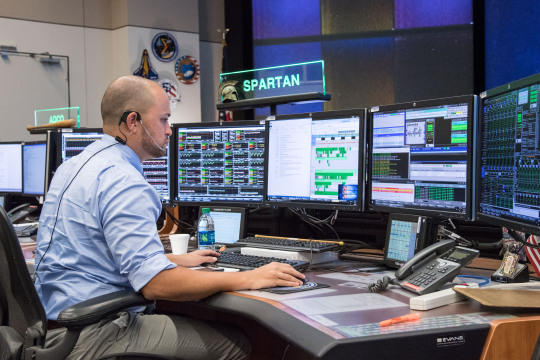
Marcos is from Caguas, Puerto Rico and earned a BS in Mechanical Engineering from the University of Puerto Rico and an MS in Aerospace Engineering from Purdue University. Spanish is his first language; English is his second.
The first time he came to the Continental US was on a trip to the Kennedy Space Center in Florida as a kid! “I always knew I wanted to work for NASA,” he said. “And I knew I wanted to be an engineer because I liked to break things to try to figure out how they worked.” He joined us in 2010 as an intern in a robotics laboratory working on conceptual designs for an experimental, autonomous land rover. He later transitioned to the space station flight control team, where he has led various projects, including major software transitions, spacewalks and commercial cargo missions!
He shares his new coworkers’ thoughts on the practical aspects of human spaceflight and believes it’s an expression of our “drive to explore” and our “innate need to know the world and the universe better.” But for him, “It’s more about answering the fundamental questions of where we come from and where we’re headed.”
Pooja Jesrani
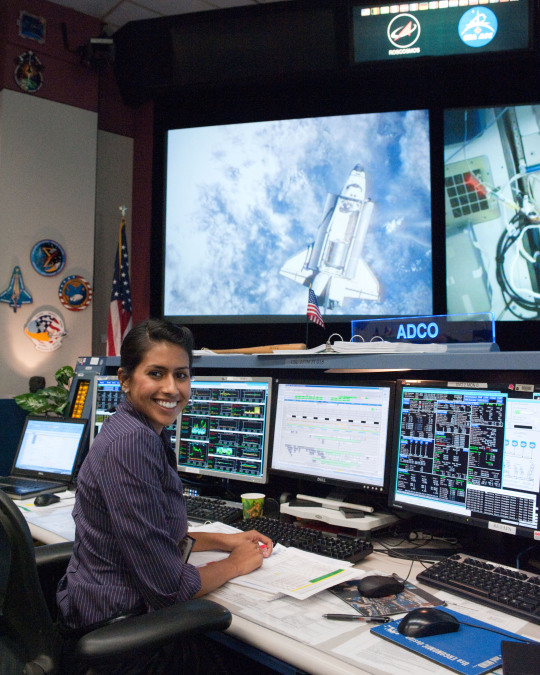
Pooja graduated from The University of Texas at Austin with a BS in Aerospace Engineering. She began at NASA in 2007 as a flight controller responsible for the motion control system of the International Space Station. She currently works as a Capsule Communicator, talking with the astronauts on the space station, and on integration with the Boeing Starliner commercial crew spacecraft.
She has a two-year-old daughter, and she’s passionate about motherhood, art, fashion, baking, international travel and, of course, her timing as a new flight director! “Not only have we been doing International Space Station operations continuously, and we will continue to do that, but we are about to launch U.S. crewed vehicles off of U.S. soil for the first time since the space shuttle in 2011. Exploration is ramping up and taking us back to the moon!” she said.” “By the time we get certified, a lot of the things we will get to do will be next-gen.”
We asked her if she had any advice for aspiring flight directors who might want to support such missions down the road. “Work hard every day,” she said. “Every day is an interview. And get a mentor. Or multiple mentors. Having mentorship while you progress through your career is very important, and they really help guide you in the right direction.”
Paul Konyha
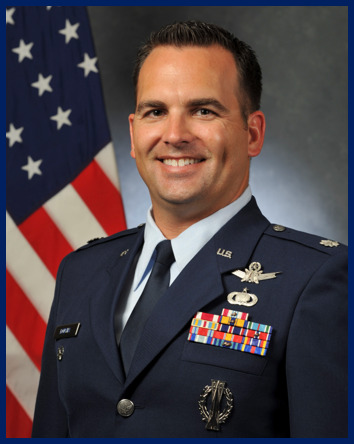
Paul was born in Manhasset, NY, and has a BS in Mechanical Engineering from Louisiana Tech University, a Master’s of Military Operational Arts and Science from Air University, and an MS in Astronautical Engineering from the University of Southern California. He began his career as an officer in the United States Air Force in 1996 and authored the Air Force’s certification guide detailing the process through which new industry launch vehicles (including SpaceX’s Falcon 9) gain approval to launch Department of Defense (DoD) payloads.
As a self-described “Star Wars kid,” he has always loved space and, of course, NASA! After retiring as a Lieutenant Colonel in 2016, Paul joined Johnson Space Center as the Deputy Director of the DoD Space Test Program Human Spaceflight Payloads Office. He’s had a rich career in some pretty high-stakes roles. We asked him for advice on handling stress and recovering from life’s occasional setbacks. “For me, it’s about taking a deep breath, focusing on the data and trying not to what if too much,” he said. “Realize that mistakes are going to happen. Be mentally prepared to know that at some point it’s going to happen—you’re going to have to do that self-reflection to understand what you could’ve done better and how you’ll fix it in the future. That constant process of evaluation and self-reflection will help you get through it.”
Rebecca Wingfield
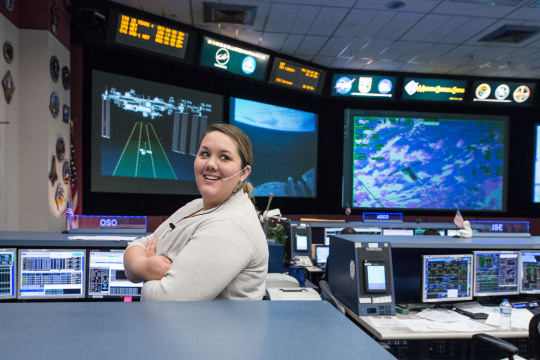
Rebecca is from Princeton, Kentucky and has a BS in Mechanical Engineering from the University of Kentucky and an MS in Systems Engineering from the University of Houston, Clear Lake. She joined us in 2007 as a flight controller responsible for maintenance, repairs and hardware installations aboard the space station.
Since then, she’s worked as a capsule communicator for the space station and commercial crew programs and on training astronauts. She’s dedicated her career to human spaceflight and has a special appreciation for the program’s long-term benefits. “As our human race advances and we change our planet in lots of different ways, we may eventually need to get off of it,” she said. “There’s no way to do that until we explore a way to do it safely and effectively for mass numbers of people. And to do that, you have to start with one person.” We asked her if there are any misconceptions about flight directors. She responded, “While they are often steely-eyed missile men and women, and they can be rough around the edges, they are also very good mentors and teachers. They’re very much engaged in bringing up the next generation of flight controllers for NASA.”
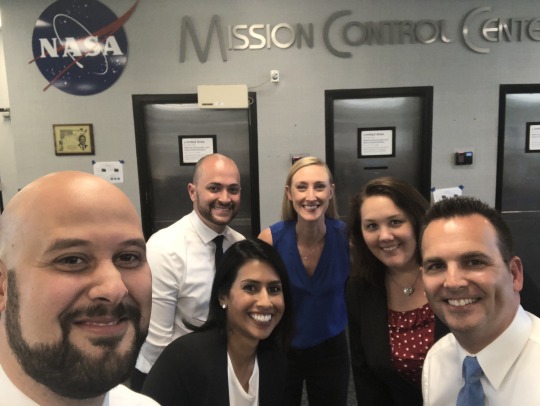
Congrats to these folks on leading the future of human spaceflight!
You can learn more about each of them HERE.
Make sure to follow us on Tumblr for your regular dose of space: http://nasa.tumblr.com
#NASA#space#mission control#flight directors#space station#human spaceflight#spaceflight#exploration#johnson space center
2K notes
·
View notes